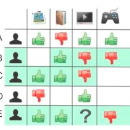Generating recommendations based on user-item interactions and user-user social relations is a common use case in web-based systems. These connections can be naturally represented as graph-structured data and thus utilizing graph neural networks (GNNs) for social recommendation has become a promising research direction. However, existing graph-based methods fails to consider the bias offsets of users (items). For example, a low rating from a fastidious user may not imply a negative attitude toward this item because the user tends to assign low ratings in common cases. Such statistics should be considered into the graph modeling procedure. While some past work considers the biases, we argue that these proposed methods only treat them as scalars and can not capture the complete bias information hidden in data. Besides, social connections between users should also be differentiable so that users with similar item preference would have more influence on each other. To this end, we propose Graph-Based Decentralized Collaborative Filtering for Social Recommendation (GDSRec). GDSRec treats the biases as vectors and fuses them into the process of learning user and item representations. The statistical bias offsets are captured by decentralized neighborhood aggregation while the social connection strength is defined according to the preference similarity and then incorporated into the model design. We conduct extensive experiments on two benchmark datasets to verify the effectiveness of the proposed model. Experimental results show that the proposed GDSRec achieves superior performance compared with state-of-the-art related baselines. Our implementations are available in \url{https://github.com/MEICRS/GDSRec}.
翻译:以用户-项目互动和用户-用户社会关系为基础提出建议,是网上系统中常见的一种常见做法。这些联系可以自然地作为图表结构数据来代表,从而自然地作为图表神经网络(GNNS)来代表社会建议,这已成为有希望的研究方向。然而,现有的图表方法没有考虑用户偏差的抵消(项目),例如,来自快速用户的低评级可能并不意味着对这一项目持负面态度,因为用户往往在普通案件中给定低评级。这种统计数据应当纳入图表模型程序。虽然过去的一些工作考虑了偏差,但我们认为这些拟议方法仅将它们作为标值分析,无法捕捉到数据中隐藏的完整偏差信息。此外,用户之间的社会联系也应当是不同的,这样,具有类似项目偏好用户的用户就会对彼此产生更大的影响。为此,我们建议基于图表的分散化协作过滤系统(GDSRec)。GDSRec将这种偏向作为矢量处理,并将这些偏向它们纳入学习用户和项目演示过程。我们认为,这些拟议的方法偏差只是将它们作为标定的标值/项目表达过程。将统计偏差与数据进行比较,通过分散的缩缩缩缩缩缩缩比比,同时将社会设计数据将比重度与社会实验数据与对比,然后将比重度比重度与社会实验,然后将现有的实验数据,然后将社会实验数据比重标定出。我们现有的进度比重度与基准比重。我们比较。我们比较,然后将社会实验,然后将现有的进度,然后将现有的进度比重。




